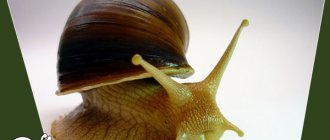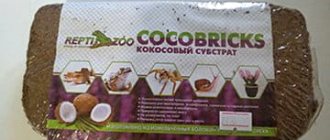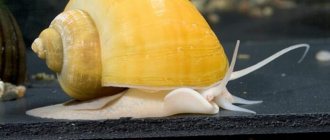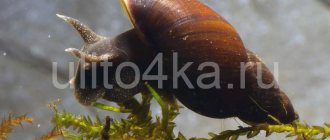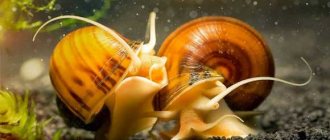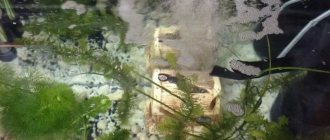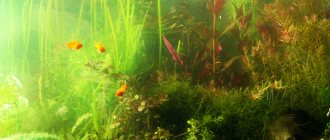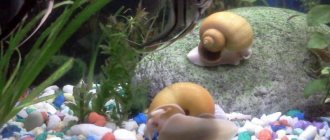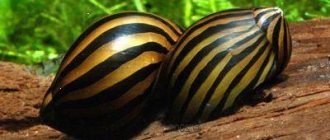Many lovers of domestic mollusks are interested in the question of why the Achatina snail burrows into the ground. But such behavior of an exotic pet should not cause premature concern if the conditions of its maintenance meet all standards. We will look at possible reasons why a snail burrows into the ground below.
A snail burrows into the ground - the norm of behavior for a mollusk
Most mollusks become active at night, and during the day they try to find a secluded dark place where no one will disturb them. Therefore, snails often bury themselves in the ground and come to the surface after sunset.
For mollusks that are kept in optimal conditions (they need the temperature, humidity level, and soil quality appropriate for the species), burying is considered the norm. So they just rest and get enough sleep, so this behavior of Achatina should not be considered strange.
Any changes in the conditions of keeping the mollusk (replacement of filler, diet, lighting, etc.) can provoke a situation when it begins to actively seek shelter. And when the snail adapts to the innovations, it will again begin to crawl over all surfaces of its terrarium.
An equally common reason for the Achatina snail burrowing into the ground is the search for a place to lay eggs.
Newborn snails do not immediately crawl to the surface from a safe place. They need to “gain strength” and build up their shell, which is very fragile in the first days of their life.
conclusions
If your pet often buries itself in the ground and remains in it for a long time, it is recommended that you first check the conditions of detention. Then inspect the animal for damage.
Unsuitable conditions or illness
The most unpleasant option for why Achatina buries itself in the ground and does not come out is its illness. In this way, the mollusk tries to cure itself. This is especially true in the case of chemical burns due to improper living conditions or food. If the gastropod inhabitant of the terrarium also refuses to eat, perhaps he is not satisfied with the quality of the offered treat or the degree of its freshness. A revision of the snail's diet can correct the situation.
Achatina feels very uncomfortable in low humidity conditions. This explains why snails burrow. The substrate retains the moisture needed by these creatures.
To maintain a normal level of humidity for the snail, the walls of the aquarium, soil and other surfaces are moistened with a sprayer twice a day.
If the environment is completely unfavorable for the mollusk, it will not only hide in the substrate, but may also close itself in its shell. The entrance to it is “sealed” with a special valve, after which the snail goes into hibernation, where it can remain for a very long time.
You can bring your pet out of suspended animation by placing it in warm (up to +30C) water for a couple of minutes.
Choosing a house for a snail
The snail is a land mollusk, so it needs a special home where optimal temperature and humidity are maintained. Therefore, she needs to arrange a terrarium. An ordinary aquarium or a large plastic food container is suitable for its role. You can also purchase a specialized terrarium for reptiles - perhaps this will be the best choice.
The minimum living space for one individual is seven liters, but the larger the snail’s house, the larger it will grow. Achatina are excellent climbers. Nature has endowed them with the gift of moving not only along vertical surfaces, but also upside down! Therefore, the terrarium must have a lid, otherwise the mollusk may attempt to escape. However, do not forget to make holes in it: ventilation is necessary, otherwise an unpleasant odor may appear, and the pet will experience oxygen starvation.
Why doesn't it bury itself?
If a snail has a good appetite, grows quickly and leads an active lifestyle, it may not have the habit of burrowing into the ground at all. This pet behavior is also considered normal. Each individual has its own preferences in habitats. Some African snails always sit in the substrate and only come out to eat. And there are also those that you can’t drive there no matter how hard you try, especially if they grew up without using soil at all: they’re simply not accustomed.
But if the strange behavior of the mollusk is caused by improper care, you need to correct the situation as quickly as possible.
The soil is too wet
Achatina do not like a waterlogged substrate due to its lumpy nature and increased density. It is difficult to bury yourself in it, and it does not warm up well. From the swampy area of the terrarium, the mollusks “flee” and crawl onto the walls of the aquarium.
An increased level of soil moisture is possible if:
- the ventilation in the terrarium is not properly organized;
- spraying the soil too often;
- if the snail accidentally overturned the water container;
- when the substrate is not capable of loosening.
Determining the degree of soil moisture is very simple: squeeze it tightly in your fist. If water flows out of it in a trickle, the face will become over-hydrated. In this case, spinning and drying or partial replacement of the substrate will be required.
Moss can be a good indicator of soil moisture. A small amount of it is placed on the surface of the soil, and as soon as it dries out, the substrate is sprayed. If the moss remains green, everything is fine with humidity.
Arrangement of the terrarium
Filler is of great importance for a terrarium with Achatina. Sand, sawdust, peat or flower compost can be used as bedding. The thickness of the filler should be at least 4 centimeters: snails are nocturnal animals, so they like to burrow into the ground during the day. You can also use wet sand for this purpose, which is the most natural habitat for snails. However, it sticks to the bodies and shells of Achatina, and the mollusks, crawling around the terrarium, stain the walls and ceiling with a mixture of sand and mucus.
Snails simply love water, so you can build an impromptu bath with fresh water. However, make sure that the depth is no more than 1 centimeter, and that the container itself is well secured and stable: carriers of heavy shells do not know how to swim at all and can drown in a harmless bowl, and we don’t need a flood. It is best to keep baby mollusks without soil and cover them with lettuce or cabbage leaves as a substrate, which the little snails eat with pleasure. In addition, this will make cleaning the terrarium easier.
Direct sunlight is contraindicated for Achatina, so think about how to heat your pet’s home. Specialized heating pads may be suitable for this. In addition, you can place a regular light bulb under the bottom and turn it on from time to time. This way, its light will not fall on the mollusks, and the heat generated will be quite enough.
Unusual substrate for snails
When it comes to soil, snails are quite picky. When replacing all the soil in the terrarium, they experience the stress of completely changing their familiar world.
The process of getting used to the new environment may take some time. You just need to be patient and wait until the snail gets used to it and begins to lead its usual lifestyle. It is not recommended to replace the soil entirely: it is better to mix it in parts.
It is generally accepted that the best type of substrate for Achatina is coconut substrate. It does not leave dirt on the snail itself, as well as on the walls and bottom of the aquarium, does not have a strong odor and is inexpensive. But such filler, if unwashed, can cause unpleasant sensations in the snail. This is the answer to the question why snails do not burrow into coconut substrate. To correct the situation, it must be washed to clean water.
Reproduction at home
Conditions for reproduction
African snails are classified as hermaphrodites, which means that their body is endowed with male and female reproductive organs. Individuals become sexually mature when they are six months to a year old. This is indicated by the appearance of a growth in the neck area. Having reached sexual maturity, the role of males goes to young Achatina, and females - to old snails.
Reproduction process
When mating, snails tilt their heads towards each other because their reproductive organs are located in the neck. This continues for 2 hours. 1.5-2 weeks after fertilization, the snails, one or both, lay clutches consisting of 200-300 eggs, but only 50% of the snails will hatch. Achatina make such clutches 4-5 times a year and bury them in the litter.
Controlling the appearance of masonry
The first mating leaves sperm inside the snail for 2 years. Thus, subsequent egg laying occurs without a partner. Therefore, when changing the soil, snail owners sometimes discover fresh clutches. Considering the fertility of Achatina, the main thing is to control the laying of eggs and transfer them to a separate container when planning to produce offspring, or destroy them.
How to care for eggs and babies
In order for the baby snails to hatch, the clutch is transferred to a separate container, where the temperature is maintained at least 25 degrees and sufficient humidity. After 14-15 days, small snails emerge from the eggs. Their size is 0.6-0.7 cm. At first, babies do not need soil; cabbage or lettuce leaves are placed on the bottom.
The offspring of snails are fed twice a day with pureed vegetables and fruits with the addition of carrots, laying the food on the leaves, but it is better if the food is kept there all the time. Older babies are fed larger pieces. To maintain the health of the young animals, it is recommended to clean the terrarium more often and more thoroughly. It is also recommended to protect Achatina snails from reproduction for up to 1.5 years.
Unfavourable conditions
When the air temperature in the terrarium is 1 - 3 degrees below normal with high humidity, the snails try to warm up by crawling onto the walls as high as possible, under the lid, where warm air accumulates. This situation occurs in the absence of normal ventilation or improper design of the terrarium.
Help save the snail!!!
Help save the snail!!!
Dear snail breeder friends, help!!! My snail, Fulika, named Horse, is the largest, active and sociable of all that I have had and still have. She stopped eating about 2 weeks ago, mostly sleeps buried in the ground, does not wake up on her own, periodically every 2-3 days I pull her out of the ground and give her a bath. It discovers food, sluggishly crawls up to it, sniffs it, and does not eat. Even a fresh cucumber doesn't excite me. It just crawls over it, or a leaf of lettuce, or a piece of sepia or other food. Previously, I gnawed at the sepia so that the cracking sound could be heard all night, and the shell regularly grew larger. I ate half the cucumber entirely without leaving a trace. And now sometimes it just hangs on the wall of the terrarium in a wrinkled state with its horns bent and sits in a daze all day long. If you bathe it again, it comes back to life for a while. I feel the muscle tone has weakened slightly. The snail is about 4 years old and has been living with me for 2 years. I feed him Chinese lettuce, cucumbers, zucchini, and less often carrots and groundnuts; there are always sepia stripes on the ground and on the ceiling in the terrarium. I regularly moisten the soil and walls with a flower spray. In the terrarium there is always water in a large drinking bowl, where the snail used to sometimes crawl entirely to bathe. Temperature at home: now 22-23 degrees, previously it was slightly higher than 25-26 degrees. The humidity in the apartment now in winter is unfortunately low: 25-28%. The soil is neutral soil for begonias mixed with pieces of Mediterranean pine bark (neutral bark, used for many terrarium animals - arthropods, reptiles, etc.). I change the soil 2-3 times a year, regularly (2-3 times a week) loosen it and remove snail poop and leftover food. About a month ago I added a one-year-old Iredalea to the Horse (now I regret it). A seemingly healthy, active and voracious snail. But the two older snails - her parents - recently died after living with me for about 11 months. Six months before death, they experienced a gradual decrease in activity, appetite, muscle tone, lack of shell growth and desire to eat sepia, the snails stopped burying themselves in the ground and simply fell asleep on the surface, being drawn into the shell. 3-4 months before death, their body acquired a slightly yellowish tint and more mucus began to be secreted in the form of lumps-clots with whitish inclusions. A month before death, the snail's shell became mostly completely white, without a colored outer layer, just white and chalky. Gradually, the snails weakened more and more until they were unable to eat or move at all. In exactly the same way, with exactly the same symptoms, 3 more Fulikas died, having lived for 2-2.5 years each. One of these fulikas lived alone all her life (did not contact anyone), was very active and grew almost to the size of this snail. And now my Horse seems to be showing the same symptoms of general weakening... WHAT AM I DOING WRONG? Are there any other chances to save a sick snail!!!??? Look at the photographs - in the photographs you can clearly see the shell, faint yellowing on the body, which I marked as green, and lumps of mucus, which began to stand out more. But it is still digging itself into the ground. I will be very grateful for practical advice!!! community.livejournal.com
Not accustomed to the ground
An adult Achatina has already formed taste preferences and habits, not only in terms of nutrition.
If the mollusk has always been in an aquarium with flower soil or a padding polyester substrate (mat), it will be very difficult for it to get used to the spit substrate.
For example, if Achatina’s previous owners are used to sleeping in a special “house” made of bark, coconut shells (ceramic flower pots) and moss, it will be difficult for her to learn to burrow into the ground.
Some snail lovers use a trick by sprinkling coconut substrate on top of well-washed flower soil so that the snail quickly adapts to the new type of bedding.
Description and types
The Achatina snail is considered the largest, smartest and quick-witted mollusk in the Archahatinidae family. There are more than 70 species in the genus with a cone-shaped shell consisting of 7-9 turns. The length of the shell can be 5 cm, others grow up to 10-25 cm. An adult weighs from 150 to 250 g.
This is interesting! The weight of the giant Achatina snail, listed in the Guinness Book of Records, is 450 g, its size is 37 cm.
The body of a gastropod is with a heart, kidneys, brain and eyes on antennae - tentacles, but there are no hearing organs. Light is perceived by cells on the surface of the body. The color of the snail shell is often yellow with reddish-brown stripes, which varies depending on the food and conditions of detention.
Common or tiger
The largest snail, from Nigeria, up to 33 cm in size and weighing 400 g. The size of domestic “tigers” is only 25 cm. The shell is barrel-shaped, from lemon color to reddish shades, along which there are black-brown stripes and dots. These Achatina are calm and lazy creatures. They move slowly and communicate little. They require special food and care conditions.
Zanzibarika
The birthplace of snails is Zanzibar. The size of the straw-yellow brown shell with stripes and dots is 12 cm. Some Zanzibaris have a pure yellow shell with a pink pointed end. Inside is white and blue. The species is viviparous, without laying eggs. Once a year, 30 small snails are born. Houses rarely contain capricious Zanzibari women.
Fulika
This species, unpretentious and omnivorous, voracious and prolific, on the contrary, is the most popular in home terrariums. He behaves compliantly and friendly with his relatives. If the right conditions are created for a fulika, it will live for more than 6 years. The color of the shell is variegated, the body is light. Sizes 14-20 cm.
Reticulata
It is one of the popular species of snails for its mobility, sociability and curiosity - it crawls with an elongated head. These are smart, fast-learning mollusks and can easily be trained to be fed at the same time. Voracious and omnivorous snails love their owner and recognize them among others. The 20-centimeter ribbed reculata shell is yellow or brown.
Immaculata
Originally from Tanzania, it is an unpretentious, omnivorous and attractive pet. The snail's body is gray or beige, with a peach stripe running down its neck. The plump chestnut shell, 15 to 22 cm long, is striped and consists of 6 whorls. The mollusk is not sociable with other snails.
Albopicta
This species is from Tanzania and is similar to the Achatina reticulata snail. The surface of the 16 cm ribbed shell is marbled. The veins are brown. The inside is white or yellow. The mollusk is not demanding in terms of maintenance, it is omnivorous and friendly.
Lemon
The Zanzibar clam has a lemon-yellow shell, 6 cm long, consisting of 4 turns. The inside is yellow. The head is dark, the sole is light. Lemon snails are viviparous; offspring are born once every 6 months.
Buraya
This 12 cm snail, originally from Mozambique, can easily be confused with a fulica, but in home terrariums it is a rare inhabitant, although sociable, omnivorous and active even during the day. Brown Achatina loves to swim when the owner is nearby.
Why does a small snail burrow into the ground, but large ones don’t want to?
A young snail still has a rather thin and fragile shell, and it itself is more susceptible to various stresses. Therefore, she tries to burrow into the soil to protect herself from external factors (sunlight, cold, too humid or dry air), as well as from natural enemies.
The shell of an adult Achatina is quite strong to protect it from environmental influences, so it feels great in its “house” and does not need to burrow into the soil.
If the Achatina snail buries itself in the ground too often and does not come to the surface for a long time, you should check the conditions of its maintenance and make sure that it itself does not have any damage.
4.5 / 5 ( 4 voices)
Why do Achatina constantly sleep (sleep all the time)
The main reason for constant sleep in Achatina is inadequate living conditions. If your animals sleep during the day and you hear noises in the terrarium at night, don't worry. African snails are peaceful and calm animals. After a hearty dinner, they like to take a nap on the walls of the terrarium or on the ceiling.
If you notice that the food you left behind remains untouched. Dig up the animals, water them with warm water and feed them. If Achatina constantly sleeps, this may be a sign of illness or poisoning. In rare cases, pregnancy. You can read more about sleep and hibernation of Achatina here.
Keeping ampularia in an aquarium
If kept alone, a very small aquarium, about 40 liters, will be enough for them.
Since snails eat a lot and also have a lot of waste after them, it would be correct to allocate at least 10-12 liters of volume per snail. Considering that they reproduce quite vigorously, it is not worth keeping them much.
But, since ampullaria themselves are rarely kept in the aquarium, it is better to count on a larger aquarium volume.
So, for 3-4 snails + fish, you need about 100 liters. Of course, a lot depends on your conditions and details. But as a rule, 10 liters per ampoule will not let you down.
Ampularia are completely peaceful and never bother fish or invertebrates. There is a misconception that they attack fish. But this is due to the fact that snails are scavengers and eat dead fish, but it seems they killed the fish. Not a single snail is capable of catching up, catching and killing a healthy and active fish.
But the fish really bother them. They can tear off their antennae, such as the Sumatran barbs, or even completely destroy them, such as dwarf tetradon, fahaka, green tetradon, clown botia or large cichlids.
Some will not be able to eat large snails, but they will clean up small ones. And they will gnaw large ones at every opportunity, which will not improve their health either.
Invertebrates such as shrimp and crayfish can also become a problem; they expertly pick snails out of their shells and eat them.
Most popular questions
Ampularia laid eggs. What to do?
If you are not worried about the snails getting into the general aquarium, then...nothing. At constant humidity and temperature, the caviar or eggs of the ampoule will hatch on their own, fall into the water and begin a completely independent life.
Catching them is not a problem, but if you want, you can place an incubator made of a plastic bottle under the clutch. Small snails will fall there and you can transfer them to the general aquarium.
The ampularia has not moved for a couple of days, what happened?
Most likely she died if she did not move for several days. An easy way to understand this is to take out a snail and smell it. But be careful, the smell can be very strong.
Dead snails in the aquarium must be removed, as they decompose very quickly and can spoil the water.
I want to give vegetables, but they float. What should I do?
It’s very simple, just prick a piece with a fork or any stainless steel object.
Do ampularia spoil plants?
Yes, some species can, especially if they are hungry. How to fight? Feed them enough.
Maintenance and care – Ulitochka RU
It is important for owners of domestic mollusks who plan to breed them to know the sex of Achatina snails and their other species. Despite,
Read more
Many lovers of domestic mollusks are interested in the question of why the Achatina snail burrows into the ground. But such behavior of an exotic pet should not cause
Read more
Any changes in the behavior of a domestic snail begin to worry their owners. One of the common questions is why the Achatina snail does not eat
Read more
The snail, as a pet in the modern world, is no longer exotic. Although you should always remember that this mollusk (exactly this
Read more
The giant African Achatina is a very prolific snail that can lay up to 1 million eggs per year. If you imagine that
Read more
Caring for the giant Achatina is not difficult. Anyone can grow such a snail at home if they take on board the tips from this
Read more
Setting up a terrarium for snails is, first of all, recreating conditions close to those in which they live in the natural environment.
Read more
The presence of water snails in aquariums is completely justified. They are needed as orderlies to clean the walls, eat up the rest of the food and
Read more
Sleep is a common occurrence for any living organism. Snails are also no exception. And each species has a dream
Read more
Ampullaria snails are one of the most popular aquarium mollusks. These gastropods have an attractive appearance and are not very demanding
Read more
Page 2
Ampullaria snails are one of the most popular mollusks found in home aquariums. These gastropods not only decorate the aquarium, but
Read more
Every person, having a pet, must understand that the animal will die after some time from old age, illness or something else.
Read more
Is it possible to bathe snails? This is the question most novice snail breeders face. And the most interesting thing is that their opinion on
Read more
Most types of snails are not difficult to keep. But every owner of an exotic animal should know how to properly maintain, what to feed the pet, how
Read more
Every pet needs proper and healthy nutrition. Therefore, in order for your snails to grow well and have a strong and shiny shell, you need
Read more
Every owner of exotic animals wants his pets to be comfortable and cozy, without having to make special efforts himself.
Read more
Proper nutrition is the key to a healthy life for every creature, and snails are no exception. A balanced and varied diet will determine
Read more
Many aquarium owners keep snails without knowing at all whether they are compatible with other inhabitants of the aquarium and what these gastropods eat.
Read more
A snail is an exotic pet and therefore requires certain conditions of detention. And very important is not only the question of what to feed,
Read more
Every person who has acquired such an exotic pet as a snail, or is just about to become its owner, has many questions.
Read more
Page 3
Every pet owner wants their pet to always be healthy. And it’s good that you can show a sick cat or dog
Read more
Most snail owners try to make their pet’s home as comfortable as possible, using natural materials to decorate the terrarium. It could be leafy
Read more
Every snail owner should know that the health of his pets directly depends on their living conditions and nutrition. Snails need, first of all,
Read more
Every pet, especially exotic pets, needs to be provided with conditions that are as close to natural as possible. And snails are no exception. Therefore it is so necessary in
Read more
Today, anyone can keep a land snail at home. It would seem that this mollusk is very undemanding in care,
Read more
As you know, for proper and healthy growth of a snail, it is necessary to feed it calcium supplements. The most popular and accessible source of calcium is
Read more
Every pet needs proper nutrition for full development and good health. The snails diet should contain vegetables, fruits, calcium and
Read more
Your snail, always cheerful and active, has suddenly stopped growing, and grooves have formed on its shell or its shell has turned white. Or you
Read more
Every owner of any pet knows that the healthy appearance and well-being of a pet depends precisely on the conditions of its keeping.
Read more
Almost every novice snail breeder faces certain problems when caring for their pets. Such problems include chipped growth,
Read more
Page 4
Recently, snails have become very popular pets. They are not demanding to care for, do not take up much space and are
Read more
Many breeders are concerned about the question of whether they need to water the Achatina snail. In today's article we will look at this issue in detail and give
Read more
Midges on snails are a problem familiar to almost everyone who has such pets. This is not only unpleasant, but also causes
Read more
Young African snails need to be provided with a nutritious diet that will contribute to their normal development and growth. The diet should not consist
Read more
Not only the health, but also the life of pets depends on the microclimate in the terrarium. The topic of today's article is optimization of humidity parameters and
Read more
Snails are rightfully popular among breeders, just like aquarium fish and other inhabitants of the aquatic environment. To such snails
Read more
Keeping snails at home is not difficult - it is difficult to find more unpretentious pets. But also to the owner of such an exotic type of pet
Read more
Not so long ago, a snail as a pet caused, to say the least, amazement. Today this can hardly surprise anyone. If you
Read more
Do you dream of having a pet, but cannot get a cat or dog due to allergies? Ideal Pets – Large Tropical Pets
Read more
Snails are common inhabitants of home aquariums. Most breeders stock shellfish in their home waters, so they are not something
Read more
Page 5
To answer the question of how snails reproduce, you must first study the structure of their body. These mollusks, for the most part, are hermaphrodites,
Read more
Snails are mollusks that can be found quite often in the home aquarium. It is typical for them to be not only a decoration of water
Read more
ulito4ka.ru

